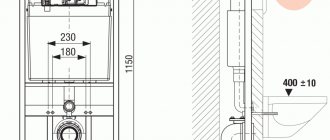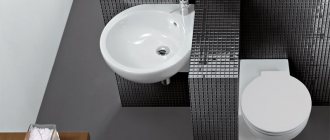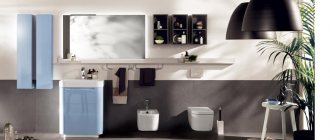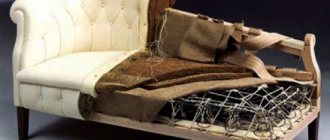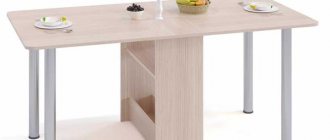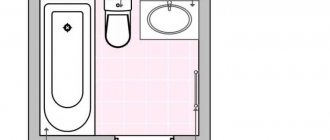Types of toilets by bowl
The shape of the bowl must ensure comfort, hygiene and functionality. And although there are several basic geometric types, there are minor differences between different manufacturers that are not noticeable at first glance.
According to the bowl design, toilet bowls are:
Funnel-shaped
The advantage of the design is high hygiene due to the location of the funnel in the center of the bowl, which ensures thorough and instant removal of defecation products. Disadvantages include the possibility of a splash.
Disc-shaped
The design is a flat platform (shelf) for the accumulation of waste, which is cleaned only under the influence of a stream of water. Bowls of this type are considered obsolete, and although they prevent splashing, due to low hygiene they are rarely produced nowadays.
Visors
The most common form, the design of which includes a special protrusion that prevents the formation of a splash and a slope that ensures the removal of defecation products from the walls of the device.
In addition to operational parameters, the shape of the bowl should ensure thorough flushing, preventing the formation of salt deposits and splashing of water.
These parameters are determined by the symbiosis of the bowl design and the type of flush.
Types of flush toilets
Depending on the type of flush, depending on the direction of water flow, toilets are produced in a direct or cascade type and a reverse circular type (shower type). Both designs have advantages and disadvantages.
Direct flush
Direct flushing is carried out by flowing water along one side of the bowl. This design is durable, but does not provide high-quality washing of the entire surface. The advantage of the system is its relatively low cost. The main disadvantages, in addition to not completely covering the bowl's capacity, are noise and splashing.
Circular flush
When organizing a circular flush system, water jets are directed at different angles to the inner surface of the bowl and move in different directions. This allows you to process up to 95% of the surface. In addition, the design has low noise.
In rare cases, manufacturers design a non-standard drain, which involves initially filling the bowl with water and then quickly draining it. This method completely flushes the inner perimeter of the toilet. The disadvantages of the design include excessive water consumption, which can exceed 8 liters.
According to the standard, the average water consumption in the drainage system should be within 6 liters, but there are systems that use two modes - full and economical. In the second case, water consumption is reduced by 2 times.
Other criteria for choosing a toilet depend on the installation conditions and the technical capabilities of the sewerage systems. Regarding these parameters, there is also a certain gradation of the types of these devices.
Vote
Which toilet did you choose?
Jaquar FNS-WHT-40951 Fonte
8.97 % ( 14 )
Laguraty 0010
8.97 % ( 14 )
Gid Tr2198-18
5.13 % ( 8 )
Grohe Euro Ceramic3932900H
5.13 % ( 8 )
AM.PMSpirit 2.0 C701700WH
12.82 % ( 20 )
Keramin Style
5.77 % ( 9 )
Vitra S50 5318B003-0075
4.49 % ( 7 )
Ideal Standard Ecco
5.13 % ( 8 )
Types of toilets for release into the sewerage system
According to the type of outlet, toilets come with vertical, horizontal and oblique outlet. The choice of the required design depends directly on the location of the sewer inlet.
Horizontal and oblique outlets are distinguished by an angle of inclination, which for the first option is almost equal to 180° (parallel to the floor), and for the second 145 - 140° in relation to the sewer inlet. The use of this type of toilet has become widespread in recent decades, thanks to the laying of sewer lines in the plane of the ceilings, combined with a system of vertical risers.
At the same time, the connection point for a toilet with an oblique outlet cannot be used to install a device with a horizontal outlet without using a system of adapters - special pipes.
Oblique release
Oblique discharge was common during the installation of riser sewer systems in apartment buildings in the 70s and 80s of the last century.
Horizontal release
Modern domestic facilities are designed to use toilets with horizontal outlet
Vertical release
In buildings of the first half of the last century, the most common was the use of vertical outlet.
In the modern construction industry, the use of vertical outlets is widespread on both American continents, which is due to the principles of installation of communications, which are mounted without reference to the walls. This method allows you to install a plumbing unit anywhere in the room, and hide the pipelines using floor and ceiling cladding materials.
Material from which the toilet is made
The first toilet, which earned recognition from its contemporaries and received a gold medal at the London Exhibition in 1884, was made of earthenware and equipped with a wooden seat. Since then, the range of materials used to produce this sanitary product has expanded significantly.
Faience
Earthenware toilets have low strength and relatively high porosity, which makes cleaning and maintaining the device difficult. The use of the material in modern production conditions is limited, since the product is fragile and susceptible to chipping and cracking. Although the developed technologies make it possible to improve these characteristics, in comparison with other materials used for the manufacture of toilets, earthenware is significantly inferior.
Porcelain
Compared to earthenware, porcelain compacts are durable, their surface is easy to clean, and their strength allows them to be used not only in individual toilets, but also in public institutions. The only significant drawback of porcelain is its significant cost due to high production costs. To reduce costs, ceramic toilets have become widespread, which, unlike porcelain, have a lower degree of surface glaze, greater weight and lower strength.
Steel and cast iron
Metal plumbing (with the exception of gold) is of the classic type and is installed in public toilets. The products are highly durable and easy to clean, but have a relatively high price. The least popular are toilets made of cast iron, due to their heavy weight and the low resistance of the enamel coating to mechanical damage.
The photo shows a stainless steel toilet.
Glass, stone
Toilets made of glass, artificial or natural stone belong to the products of the “modern” category. These plumbing fixtures are distinguished by their high price and exquisite appearance. The lack of strength for toilets made of glass and natural stone is compensated for by the use of artificial substitutes, which are visually and tactilely inferior to their natural counterparts.
Plastic
Modern technologies make it possible to produce toilets from reinforced acrylic. These products have high strength, are easy to maintain and have virtually no porous structure, which is the maximum indicator of hygiene. The disadvantages of plastic plumbing fixtures include susceptibility to deformation caused by mechanical stress or high temperatures.
Methods of fixing toilets
Depending on the installation method, toilets are divided into wall-hung and floor-mounted, while floor-mounted toilets are divided into simple and installed close to the walls (wall-mounted).
Floor standing toilets
Floor-standing toilets are distinguished by their low cost and ease of installation. Floor-standing plumbing fixtures are recommended to be installed in spacious toilet rooms. Installation is carried out using anchor bolts and takes a minimum of time. In addition, this design allows for dismantling without harm to the floor covering. For installation in small toilet rooms, attached (wall-mounted) structures are used.
Wall-mounted toilets designed with a special flushing system are not inferior in compactness to wall-hung models.
Among floor-standing toilets, we should highlight a specially shaped toilet that can be installed in a corner. It is not only a design find, but can also be a very practical solution in organizing a bathroom.
Wall hung toilets
The wall-hung toilet is designed for installation in small spaces. The fastening system of these devices is designed for a load of 400 kg or more. The advantage is more accessible space for sanitary cleaning, and the saved space allows you to equip a bathroom with a bidet in a small space.
The bowls are mounted above the floor surface and mounted in a block or frame manner. The frame structure provides rigid fastening of the toilet to the wall and floor and is located inside the false wall. The necessary fittings and pipes are attached to the structure. In contrast to this method, block installation involves attaching the frame to a load-bearing wall. The installation depth is 150 mm. Saving space is only possible if you use an existing “false” structure or install special niches reinforced with metal beams.
The photo shows a wall-hung toilet in a classic design.
The whole truth about smart toilets: are they any good?
Smart toilets are only gaining popularity. In China or Japan, devices have long ceased to be a luxury. Equipped with:
- automatic flush;
- auto-cleaning;
- water saving function;
- night light;
- Bluetooth and MP3;
- backlight;
- massage bidet;
- built-in sensors that warn of problems and malfunctions.
Some smart toilet models can also perform urine tests.
Smart toilets are a “breakthrough” in plumbing equipment, popular in developed countries. How often the proposed options will be used in everyday life in Russia is another question.
Tank mounting options
There are several options for placing the flush cistern, but depending on the connection with the toilet, there are separate and joint types of construction.
Separate toilet and cistern
The tank is mounted under the ceiling and connected to the toilet with a plastic or metal pipeline. The drainage device is controlled by a lever, which is extended by a flexible handle on a chain, rope or similar material. The design was developed more than a century ago and has the advantage of a naturally high drain rate, which ensures high-quality performance compared to other analogues.
Modern separate systems are installed with a hidden tank, which in the open version does not have an aesthetic appearance, but there are also decorative options.
Shared toilet and cistern
The joint design (compact) involves attaching the tank directly to the toilet or to a monolithic shelf. This system is widespread because it does not require additional installation work and involves less use of materials. In addition, the compact can be positioned regardless of the distance to the walls and the ability to use vertical surfaces as a load-bearing base.
The most common option for attaching a toilet tank.
Monoblock toilet
This is a kind of toilet combined with a tank, but the tank is not attached to the toilet using bolts and a rubber seal, but the entire block is cast at once.
This design is more reliable and hygienic, but it is more cumbersome.
Hidden tank
To implement design solutions or to increase space in the toilet room, modern flush cisterns can be mounted hidden using a false wall. The tank must be made of plastic, and the device must be installed using the frame method. Buttons or control levers are brought to the surface using special mechanical extensions, which are provided by the design of the tank.
Most often, such a system is used when installing wall-mounted toilets.
Toilets without cistern
In modern plumbing equipment, especially for the installation of public toilets, toilets with a drain system directly from the pipeline are used. Water is supplied from the mains and controlled by a mechanical or electronic valve.
What are the types of water supplies?
Water is supplied to the drain tank either from the side or from below. The noise level when draining water from the tank depends on the type of supply.
Lower
Less common. The connection is more complicated, but the noise level is almost zero. When filling the tank, the water does not make noise or splash.
Side
Common type. The tube through which the water supply is organized is connected to the right or left side of the tank. The connection is simple, but the noise level is high.
Flexible
Flexible supply allows you to arrange the supply of a more complex system. For this purpose, rubber flexible pipes are used, additionally reinforced with metal threads.
Hard
A hard water supply involves the use of pipes made of durable steel (usually corrugated) or copper. Elements in contact with water are made of stainless steel to avoid corrosion.
